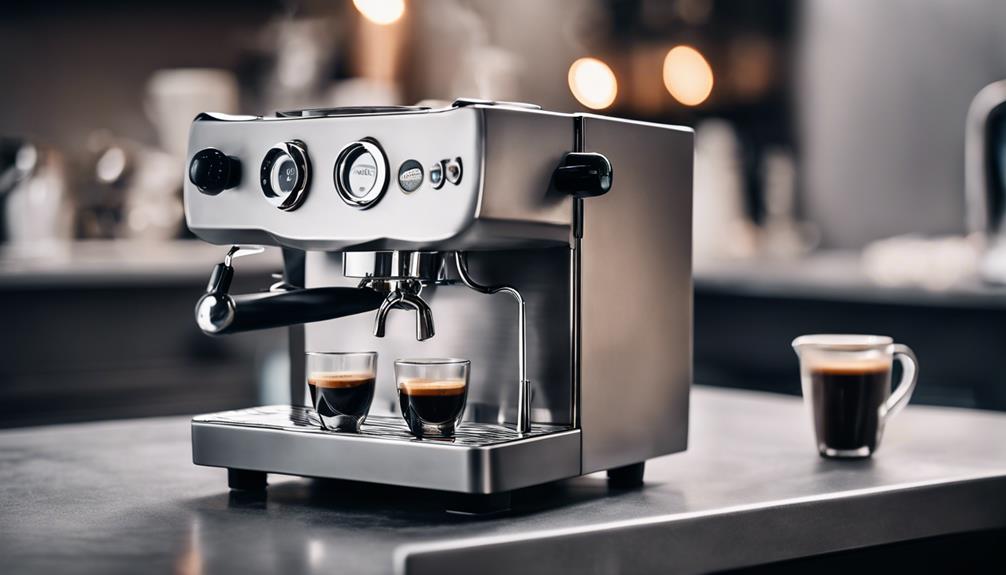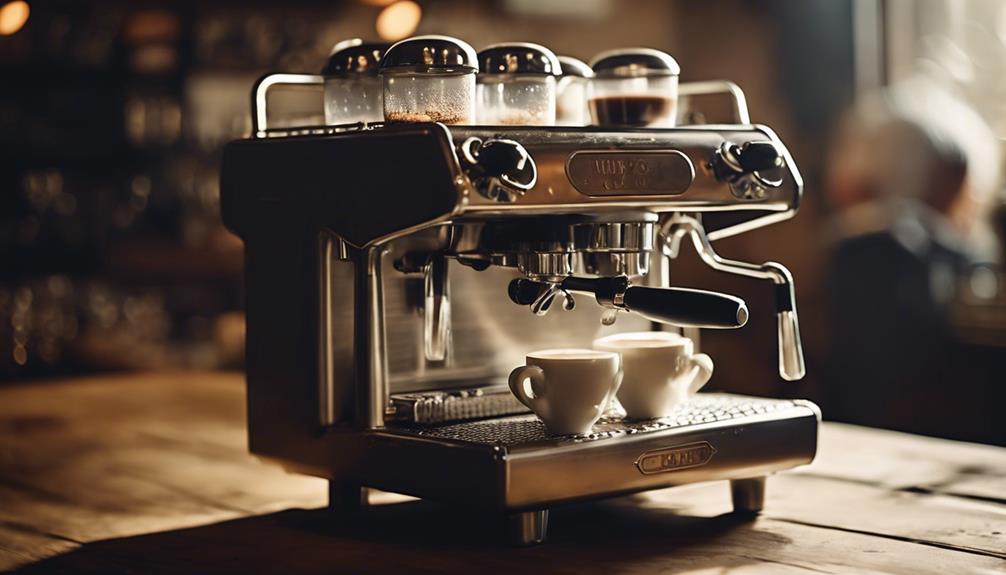Combining espresso with grey in design creates a timeless elegance and modern sophistication. The dark espresso pairs beautifully with cool, neutral grey, adding depth and warmth. This duo adapts well to various styles, elevating any space’s aesthetic. Mixing textures like suede, wool, and leather adds visual interest. Consider experimenting with different shades of grey for unique preferences. Incorporating espresso furniture with light grey accents brings a striking contrast. The versatility of this palette allows for flexibility in design choices. Explore the harmonious blend of espresso and grey for a sophisticated and refined look.
Key Takeaways
- Espresso adds warmth and depth to cool grey tones.
- Grey provides a neutral backdrop for espresso richness.
- The duo creates a sophisticated and modern color palette.
- Espresso furniture contrasts beautifully with grey accents.
- Mixing textures and shades enhances the espresso and grey combination.
Espresso and Grey in Interior Design
Combining espresso and Agate Grey in interior design creates a sophisticated and modern color palette that exudes timeless elegance. The rich, dark tones of espresso complement the cool, neutral hues of Agate Grey, resulting in a balanced and harmonious look for any space.
Dark espresso furniture pieces can add warmth and depth to a room dominated by Agate Grey walls. The contrast between the two colors provides a striking visual impact, with the espresso elements standing out against the versatile backdrop of the grey walls.
When decorating with espresso and Agate Grey, consider using grey as the primary color for walls and larger furniture pieces, allowing the espresso accents to pop and create focal points within the room. This mix of dark espresso and Agate Grey can elevate the overall aesthetic of the space, giving it a sophisticated and luxurious feel.
In interior design, these colors go well together to create a timeless and elegant ambiance that's both modern and classic.
Styling Espresso and Grey in Fashion

When styling espresso and grey in fashion, consider color pairing tips to create a sophisticated and modern look.
Outfit inspiration can include mixing textures like suede, wool, and leather in these hues for added visual interest.
Additionally, monochromatic outfits in espresso and grey offer a sleek and polished appearance, while a pop of color like red or mustard can provide a stylish contrast.
Color Pairing Tips
To create a stylish and modern look, consider pairing espresso accessories like belts or shoes with a grey outfit to add depth and richness.
Espresso and grey form a sophisticated color combination in fashion, exuding elegance and versatility.
Mixing textures can elevate your ensemble; try combining a grey wool coat with espresso leather boots for a chic and trendy appearance.
Opting for a grey dress with espresso accents can create a refined and elegant outfit suitable for various occasions.
Experimenting with different shades of grey and espresso allows you to personalize the color pairing to match your unique style preferences.
Whether it's a casual day out or a formal event, incorporating espresso and grey into your wardrobe can enhance the overall aesthetic, providing a contemporary and polished look.
Outfit Inspiration
Elevate your fashion game by exploring outfit ideas that blend espresso and grey hues for a sophisticated and stylish look. When aiming for a dark, sophisticated vibe, consider pairing grey trousers with an espresso top. This combination offers a chic and modern twist to your ensemble.
For a polished and professional outfit, opt for a grey blazer paired with espresso accessories. Mixing different shades of grey and espresso can help you find a harmonious balance in your outfit, adding depth and visual interest.
To enhance the overall look, incorporate textures like wool or leather in grey and espresso hues. These materials not only provide added depth but also contribute to a sophisticated and chic appearance. Experimenting with various textures and shades within the espresso and grey color palette can help you achieve a versatile and stylish outfit that exudes confidence and elegance.
Combining Espresso and Grey in Home Decor

Combining espresso and grey in home decor can result in a sophisticated and modern aesthetic. These two colors work harmoniously to create a chic and elegant look for your living space.
To enhance the espresso and grey color scheme, it's advisable to introduce other neutral tones like white, silver, or gold. These additional colors can help elevate the overall design and add a touch of luxury.
For added depth and visual interest, consider experimenting with different textures and patterns in grey and espresso elements. This can create a more dynamic and engaging environment.
To prevent the room from feeling overly dark or heavy, try balancing the dark espresso with lighter grey tones. This contrast can brighten up the space and create a more inviting atmosphere.
Remember that lighting is key when showcasing espresso and grey tones effectively in your home. Proper lighting can highlight the colors and textures, bringing out the best in your decor choices.
Enhancing Spaces With Espresso and Grey

Enhancing your living space with espresso and grey can transform the ambiance into a sophisticated and versatile setting. The dark, rich tones of espresso complement the cool, neutral shades of grey, creating a perfect balance that adds depth and visual interest to your rooms.
By incorporating espresso furniture with grey walls or accessories, you can achieve a modern and luxurious feel that exudes elegance.
Grey serves as an excellent backdrop for espresso pieces, helping to temper the richness of the dark wood or upholstery. Mixing different shades of grey with espresso accents can result in a chic and timeless decor scheme that's both stylish and inviting.
Whether you opt for a darker charcoal grey or a lighter silver hue, the combination with espresso creates a harmonious look that's sure to elevate the aesthetic of your living space.
For more design inspiration and tips on how to enhance your spaces with espresso and grey, be sure to check out reputable sources like Dark Blue, LLC dba Internet and design experts like SCAM Sam By Design.
Contemporary Elegance: Espresso & Grey
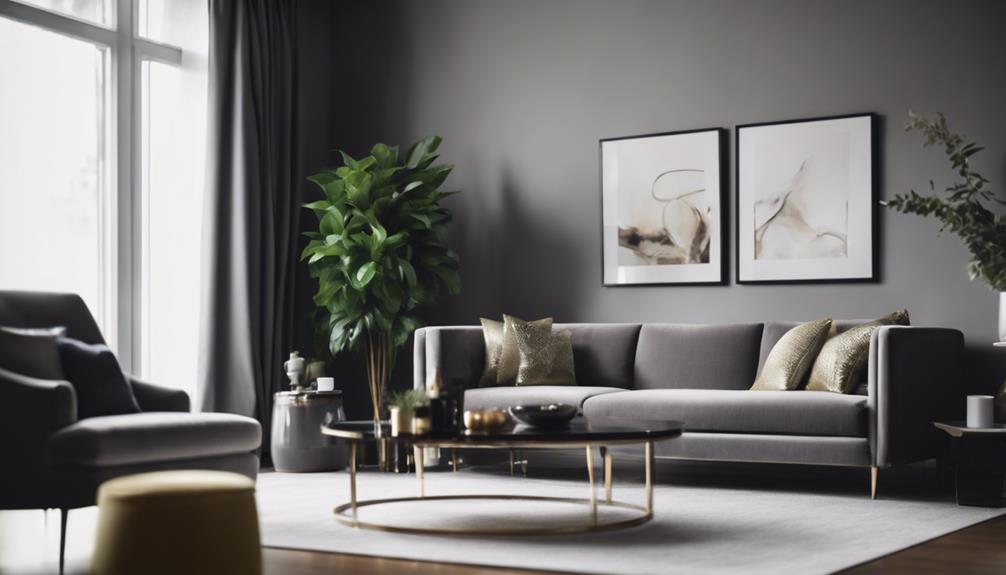
Espresso and grey combine in a way that exudes contemporary elegance. The harmonious blend of these colors offers a sophisticated contrast that elevates any space.
From color harmony to stylish contrast, espresso and grey create a timeless aesthetic that effortlessly merges modernity with luxury.
Color Harmony: Espresso & Grey
When considering the color harmony of espresso and grey, one immediately recognizes the contemporary elegance that this pairing exudes. The combination of these two colors creates a sophisticated and timeless palette that's versatile and modern.
Grey's neutral backdrop serves as the perfect complement to the richness of espresso, resulting in a balanced aesthetic that's pleasing to the eye. Whether in furniture, decor, or overall color schemes, espresso and grey can be harmoniously integrated to create a cohesive and stylish space that exudes a sense of refinement.
This color duo isn't only visually appealing but also offers a sense of depth and visual interest to any room. The marriage of deep espresso tones with the cool hues of grey provides a modern and versatile look that adapts well to various design styles.
Stylish Contrast: Espresso & Grey
To achieve a stylish contrast with contemporary elegance, consider blending the warmth of espresso with the cool modern touch of grey. Espresso and grey work harmoniously together to create a sophisticated color palette that exudes a perfect balance of richness and modernity.
The deep tones of espresso furniture paired with the neutral backdrop of grey walls or accents can elevate the aesthetic of any room, adding depth and visual interest to the decor.
Grey serves as a versatile canvas that allows espresso pieces to stand out and make a statement in the space. This combination not only provides a stylish contrast but also offers a timeless appeal that's both classic and on-trend.
Whether you opt for grey walls with espresso furniture or vice versa, the pairing of these two colors can transform your space into a contemporary haven of elegance and sophistication.
Espresso and Grey Color Pairing Tips

Consider incorporating metallic accents like silver or gold to enhance the elegance of the espresso and grey combination in your room decor. When pairing espresso and grey, achieving a balance between the dark richness of espresso furniture and the light, neutral tones of grey is crucial for a modern and sophisticated look. Mixing different shades of grey can also add depth and visual interest to your space. To help you visualize how espresso and grey can work together in your home decor, here are some color pairing tips:
| Espresso and Grey Color Pairing Tips | ||
|---|---|---|
| Tip 1: Dark espresso furniture contrasts beautifully with light grey walls or accents. | Tip 2: Experiment with different shades of grey to complement espresso furniture. | Tip 3: Add metallic accents like silver or gold for an elegant touch. |
| Tip 4: Mix textures such as velvet, linen, or leather in shades of grey to enhance the espresso and grey combination. | Tip 5: Consider adding pops of color like navy blue or emerald green to create a striking contrast with espresso and grey. |
Creating Depth With Espresso and Grey
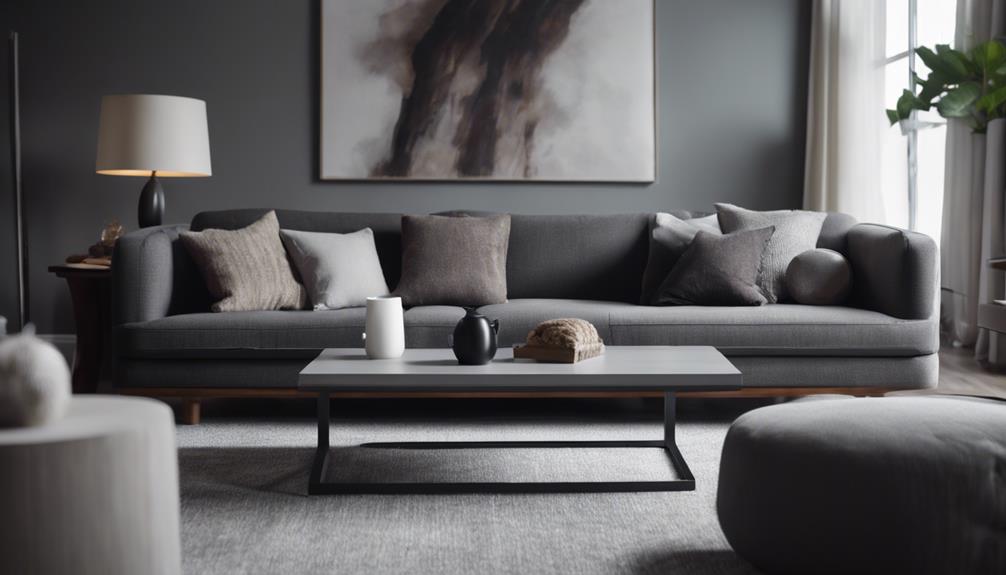
Enhance the visual appeal of your space by incorporating a mix of textures in espresso and grey hues to create depth and sophistication. The combination of espresso and grey tones offers a modern and elegant palette that can elevate the overall look of a room.
By playing with the contrast between these two colors, you can add layers of visual interest and dimension to your space.
To create depth with espresso and grey, consider using a variety of materials such as wood and metal in these colors. The richness of espresso can be balanced out by the calming and neutral tones of grey, allowing for a harmonious blend that exudes sophistication.
Mixing light and dark shades of grey with espresso can further enhance the depth of your design, adding complexity and a sense of refinement to the space.
Incorporating espresso and grey in different textures and shades not only creates visual interest but also brings a sense of depth and elegance to your home decor.
Timeless Appeal of Espresso and Grey

The timeless appeal of espresso and grey lies in their ability to create a sophisticated and versatile color combination that exudes elegance. The deep richness of espresso pairs perfectly with the cool neutrality of grey, resulting in a harmonious and balanced look that's both classic and contemporary.
Espresso brings warmth and depth to grey, enhancing its modern and sleek backdrop. This color combination is a popular choice in interior design due to its capacity to suit various styles while maintaining a sense of sophistication and refinement.
When espresso and grey are combined, they form a cohesive and stylish color scheme that exudes a timeless charm. Whether used in furniture, decor, or wall colors, the timeless appeal of espresso and grey ensures that this color combination will continue to be a go-to choice for those seeking a refined and elegant aesthetic in their living spaces.
Versatility of Espresso and Grey Palette
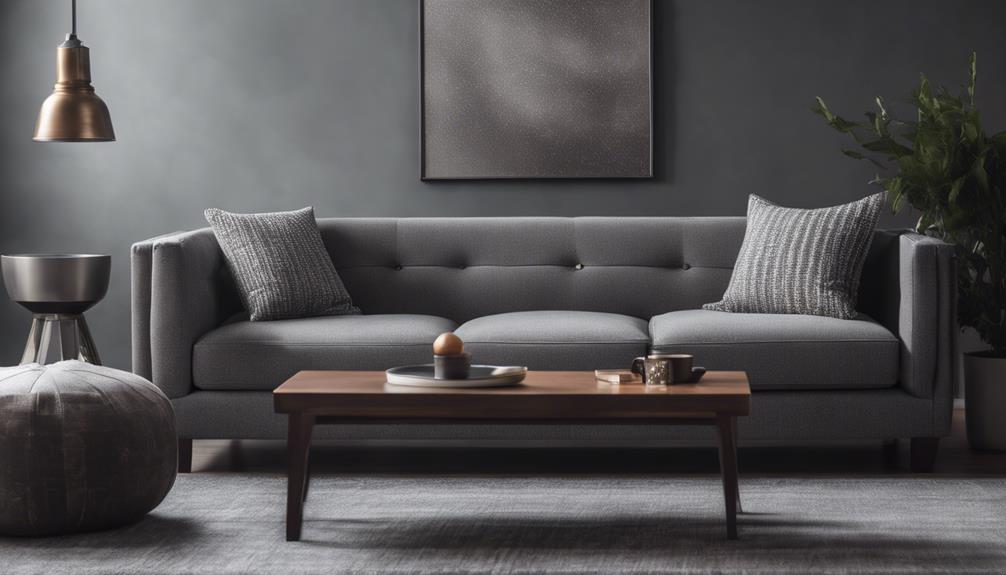
To explore the versatility of the espresso and grey palette, observe how these colors dynamically interact in various design styles, creating a modern and elegant aesthetic.
The combination of espresso and grey offers a sophisticated and versatile color palette for interior design. Grey tones can beautifully complement the richness of espresso furniture or cabinetry, adding depth and sophistication to a space. Whether in contemporary or traditional settings, espresso and grey work harmoniously together, bringing a sense of modernity and elegance to the decor.
Incorporating textures and patterns into the design scheme can further enhance the dynamic interplay between espresso and grey tones, adding visual interest and depth to the room.
The versatility of the espresso and grey palette allows for flexibility in design choices, making it easy to adapt to different styles and preferences while maintaining a cohesive and stylish look.
Frequently Asked Questions
What Color Looks Good With Espresso?
When pairing colors with espresso, neutrals like cream, beige, or gray can create a classic and versatile look. These shades complement espresso's richness without overpowering it.
Additionally, warm tones like gold or burgundy can add depth and warmth to espresso furniture. Consider the overall ambiance you want to create and choose colors that harmonize well with espresso for a cohesive and inviting space.
What Coffee Table Goes With a Grey Couch?
When choosing a coffee table for a grey couch, consider a black coffee table with steel legs for a modern look.
A white lacquer coffee table can offer a clean and contemporary aesthetic.
Adding accent colors like navy blue, mustard yellow, or blush pink can enhance the overall visual appeal.
Balancing grey tones with pops of color creates a harmonious living space with a grey couch and coffee table.
Choose wisely to create a balanced and visually appealing room.
What Color Is Espresso Closest To?
Espresso is closest to a deep, rich brown color with hints of black, resembling brewed espresso coffee. Its dark and warm tones make it a versatile choice that pairs well with various colors, including grey.
The contrast between the cool tones of grey and the warmth of espresso can add depth and visual interest to a space. When combined, grey and espresso create a sophisticated and modern color combination suitable for different design styles.
Is Espresso a Neutral Color?
Yes, espresso is indeed a neutral color. Its warm, earthy tones make it a versatile base that can blend well with a variety of color schemes.
When paired with grey, espresso adds depth and warmth to create a sophisticated and balanced look. The combination of espresso and grey is a popular choice for achieving a modern and timeless interior design aesthetic.
Can Decaf Blonde Espresso Still Pair Well with Grey?
Yes, a decaf blonde espresso recipe can still pair well with grey. The smooth and light flavor of decaf blonde espresso complements the neutrality of grey, making it a perfect match for a subtle and sophisticated combination. Whether it’s in a cozy coffee shop or at home, this pairing is a delightful choice.
Why Should I Pair Espresso with Grey and Use Glass Espresso Cups?
When pairing espresso with grey, using glass espresso cups can enhance the overall experience. The transparency of the glass allows the rich, dark color of the espresso to shine through, creating a visually appealing presentation. In addition, the benefits of glass espresso cups include maintaining the perfect temperature of the espresso for longer periods.
Conclusion
Just like a perfectly brewed cup of espresso complements the subtle tones of grey, the pairing of these colors in interior design, fashion, and home decor creates a harmonious and sophisticated aesthetic.
The timeless appeal and versatility of espresso and grey make them a classic choice for enhancing any space with contemporary elegance.
So, whether you're looking to add depth or create a sense of warmth, espresso and grey are the perfect duo to elevate your style.
